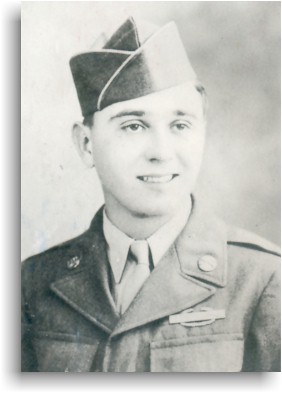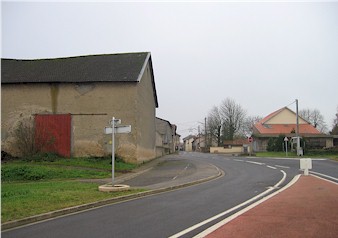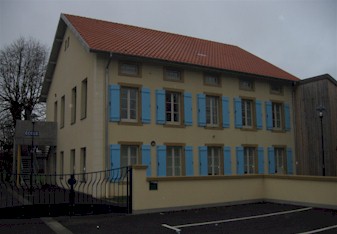|
Donald A. Fuesler |
 |
 |
| Company
"Anti-Tank", 378th Infantry Regiment |
 I
was a cannoneer on a 57mm anti-tank gun in the 3rd
batallion of the 378th regiment of the 95th Division.
We were in a defensive position in Verneville, France.
We were in the schoolhouse and city hall at the edge of
the town. We were defending the crossroad there
against armored attack by the 17th Panzer Grenedier
Division. The repaired hole from a
German 88mm in
the stone barn at the crossroads can still be seen today.
I
was a cannoneer on a 57mm anti-tank gun in the 3rd
batallion of the 378th regiment of the 95th Division.
We were in a defensive position in Verneville, France.
We were in the schoolhouse and city hall at the edge of
the town. We were defending the crossroad there
against armored attack by the 17th Panzer Grenedier
Division. The repaired hole from a
German 88mm in
the stone barn at the crossroads can still be seen today.
We had an observation post in the barn and
observed the German soldiers on the edge of the woods in
the distance. We lived in the back corner room
facing the farm and crawled in and out of the window.
An old couple, husband and wife, stayed and lived at the
farm. I later found out that they lived through the
war.
Our
gun was in an old shed next to the schoolhouse aimed at
the crossroads just below the barn.One night a German
patrol came into the farm area. Frederick Krebs and
I were on guard behind the wall near the corner of
the schoolhouse. We frightened away the patrol and
the next morning when I went up in the hayloft to man the
observation post, I noticed some movement under the hay.
I challenged the German under the hay. He did not
come out, and not wanting to give away our position in the
barn by shooting him, I took a pitchfork and rammed it
into the moving hay. A terrible scream ensued, and a
pig came out with a pitchfork stuck in his back. The
old farmer came out and rescued his pig.
 |
On
the left
: Picture of the actual cross road. We can
see the stone barn on the left and the school on the
right. |
|
On
the right
: Picture of the school renovated. |
 |
In mid November we moved to a forward assembly area above
Woippy. From there we moved past the big fort near
Le Ban San Martin down to the Moselle to cover the attack
on the Pont du Sauvage.
Later that day we attempted to cross the Moselle and get
to the island, but the current was too swift and swept us
down river. Fortunately we were able to get back
onshore. We went back through Le Ban St Martin past
all the wounded and dead horses and dead Germans to a foot
bridge that the engineers had built. We went to the
island and participated in the battle there. That
night I was sent back to get rations and ammunition, but
on the way back was knocked into the river by enemy
shellfire aimed at trying to knock out the pontoon bridge.
Soaking wet and freezing to death, I went back to Le Ban
where I found the engineers in an old German barracks.
A major there gave me some brandy, too much, and I awoke
the next morning in a warehouse filled with canned
condiments and wearing a dry German uniform.
MERDE!!! My old buddy Don Wentz came to my rescue
and brought me a clean dry uniform from the batallion aid
station. We then went back to the island and then on
into Metz where I shot a German sniper out of the top of
the railroad station. We ended up at the Hotel
Royal, which became our batallion headquarters.
Whenever we would hear small arms fire we would head in
that direction to find the FFI in a fire fight with holed
up Germans. We would pull the FFI back and the
Germans would surrender to us. They knew better that
to surrender to the FFI.
At four o'clock in the afternoon the great bell of the
cathederal began ringing and people streamed out into the
streets celebrating their liberation. It was one of
the most moving sights of my life. Wentz and I were
exhausted so we found a bed in the old Hotel National, now
the Ibis, and went to bed in room #27.
Early the next morning we awoke to sounds of gunfire, and
looking out the window saw we were under attack by troops
from the 5th Division which was on our right flank.
They had not received the message that we had liberated
the city a day earlier. We tore the sheets off the
bed and began waving them out of the window of the
hotel. After a short time the attack stopped and we
went back to the Hotel Royal. Metz was now calm. and
we spent a little time exploring the city. A large
church not far from the now Hotel Mercure was filled with
confisicated arms which the Nazis had taken from the
French. It was a huge arsenal.
After less than a day in Metz we were told to leave and
went to Boulay where we got ready for an assualt on the
Siegfried Line.
I want to
thank Donald A. Fuesler for his testimony and the use of
his photographs.
|

